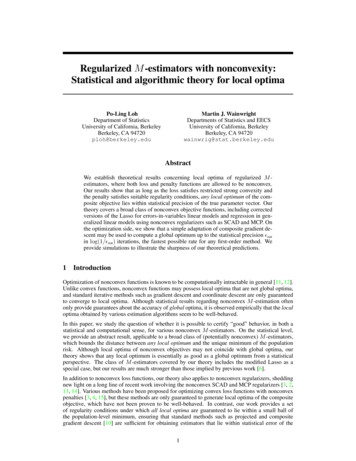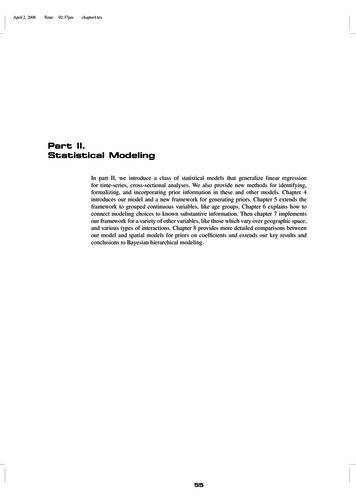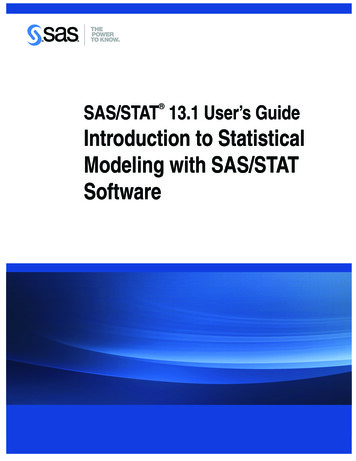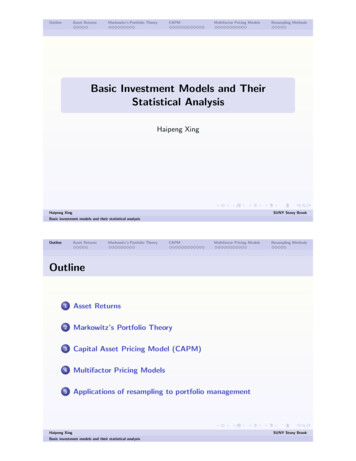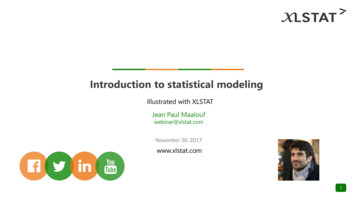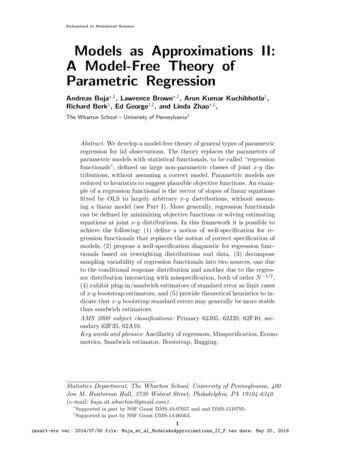
Transcription
Submitted to Statistical ScienceModels as Approximations II:A Model-Free Theory ofParametric RegressionAndreas Buja ,‡ , Lawrence Brown ,‡ , Arun Kumar Kuchibhotla‡ ,Richard Berk‡ , Ed George†,‡ , and Linda Zhao ,‡ ,The Wharton School – University of Pennsylvania‡Abstract. We develop a model-free theory of general types of parametricregression for iid observations. The theory replaces the parameters ofparametric models with statistical functionals, to be called “regressionfunctionals”, defined on large non-parametric classes of joint x-y distributions, without assuming a correct model. Parametric models arereduced to heuristics to suggest plausible objective functions. An example of a regression functional is the vector of slopes of linear equationsfitted by OLS to largely arbitrary x-y distributions, without assuming a linear model (see Part I). More generally, regression functionalscan be defined by minimizing objective functions or solving estimatingequations at joint x-y distributions. In this framework it is possible toachieve the following: (1) define a notion of well-specification for regression functionals that replaces the notion of correct specification ofmodels, (2) propose a well-specification diagnostic for regression functionals based on reweighting distributions and data, (3) decomposesampling variability of regression functionals into two sources, one dueto the conditional response distribution and another due to the regressor distribution interacting with misspecification, both of order N 1/2 ,(4) exhibit plug-in/sandwich estimators of standard error as limit casesof x-y bootstrap estimators, and (5) provide theoretical heuristics to indicate that x-y bootstrap standard errors may generally be more stablethan sandwich estimators.AMS 2000 subject classifications: Primary 62J05, 62J20, 62F40; secondary 62F35, 62A10.Key words and phrases: Ancillarity of regressors, Misspecification, Econometrics, Sandwich estimator, Bootstrap, Bagging.Statistics Department, The Wharton School, University of Pennsylvania, 400Jon M. Huntsman Hall, 3730 Walnut Street, Philadelphia, PA 19104-6340(e-mail: buja.at.wharton@gmail.com). †Supported in part by NSF Grant DMS-10-07657 and and DMS-1310795.Supported in part by NSF Grant DMS-14-06563.1imsart-sts ver. 2014/07/30 file: Buja et al ModelsAsApproximations II F.tex date: May 20, 2019
2A. BUJA ET AL.“The hallmark of good science is that it uses models and ’theory’ but neverbelieves them.” (J.W. Tukey, 1962, citing Martin Wilk)1. INTRODUCTIONWe develop in this second article a model-free theory of parametric regression,assuming for simplicity iid x-y observations with quite arbitrary joint distributions. The starting point is the realization that regression models are approximations and should not be thought of as generative truths. A general recognitionof this fact may be implied by the commonly used term “working model,” butthis vague term does not resolve substantive issues, created here by the fact thatmodels are approximations and not truths. The primary issue is that model parameters define meaningful quantities only under conditions of model correctness.If the idea of models as approximations is taken seriously, one has to extend thenotion of parameter from model distributions to basically arbitrary distributions.This is achieved by what is often called “projection onto the model,” that is, finding for the actual data distribution the best approximating distribution withinthe model; one defines that distribution’s parameter settings to be the target ofestimation. Through such “projection” the parameters of a working model areextended to “statistical functionals,” that is, mappings of largely arbitrary datadistributions to numeric quantities. We have thus arrived at a functional pointof view of regression, a view based on what we call regression functionals.The move from traditional regression parameters in correctly specified models to regression functionals obtained from best approximations may raise fearsof opening the gates to irresponsible data analysis where misspecification is ofno concern. No such thing is intended here. Instead, we rethink the essence ofregression and develop a new notion of well-specification of regression functionals, to replace the notion of correct specification of regression models. In thefollowing bullets we outline an argument in the form of simple postulates. The essence of regression is the asymmetric analysis of association: Variableswith a joint distribution P are divided into response and regressors. Motivated by prediction and causation problems, interest focuses on properties of the conditional distribution of the response given the regressors. The goal or, rather, the hope is that the chosen quantities/functionals ofinterest are properties of the observed conditional response distribution,irrespective of the regressor distribution. Consequently, a regression functional will be called well-specified if it isa property of the observed conditional response distribution at hand, irrespective of the regressor distribution.The first bullet is uncontroversial: asymmetric analysis is often natural, as in thecontexts of prediction and causation. The second bullet remains at an intendedlevel of vagueness as it explains the nature of the asymmetry, namely, the focus onthe regressor-conditional response distribution. Intentionally there is no mentionof regression models. The third bullet also steers clear of regression models byaddressing instead quantities of interest, that is, regression functionals. In thisand the last bullet, the operational requirement is that the quantities of interestnot depend on the regressor distribution. It is this constancy across regressorimsart-sts ver. 2014/07/30 file: Buja et al ModelsAsApproximations II F.tex date: May 20, 2019
MODELS AS APPROXIMATIONS II3distributions that turns the quantities of interest into properties of the conditionalresponse distribution alone.All this can be made concrete with reference to the groundwork laid in Part I,Section 4. Consider the regression functional consisting of the coefficient vectorobtained from OLS linear regression. It was shown in Part I that this vectordoes not depend on the regressor distribution (is well-specified) if and only ifthe conditional response mean is a linear function of the regressors. Thus thecoefficient vector fully describes the conditional mean function, but no otheraspect of the conditional response distribution. Well-specification of the OLScoefficient functional is therefore a weaker condition than correct specification ofthe linear model by setting aside homoskedasticity and Gaussianity which arelinear model requirements not intimately tied to the slopes.A desirable feature of the proposed definition of well-specification is that itgeneralizes to arbitrary types of parametric regression or, more precisely, to thestatistical functionals derived from them. In particular, it applies to GLMs wherethe meaning of well-specified coefficients is again correct specification of the meanfunction but setting aside other model requirements. Well-specification furtherapplies to regression functionals derived from optimizing general objective functions or solving estimating equations. Well-specification finally applies to any adhoc quantities if they define regression functionals for joint x-y distributions.The proposed notion of well-specification of regression functionals does notjust define an ideal condition for populations but also lends itself to a tangiblemethodology for real data. A diagnostic for well-specification can be based onperturbation of the regressor distribution without affecting the conditional response distribution. Such perturbations can be constructed by reweighting thejoint x-y distribution with weight functions that only depend on the regressors. Ifa regression functional is not constant under such reweighting, it is misspecified.In practice, use of this diagnostic often works out as follows. Some form ofmisspecification will be detected for some of the quantities of interest, but thediagnostic will also aid in interpreting the specifics of the misspecification. Thereason is that reweighting essentially localizes the regression functionals. For thecoefficients of OLS linear regression, for example, this means that reweightingreveals how the coefficients of the best fitting linear equation vary as the weightfunction moves across regressor space. Put this way, the diagnostic seems relatedto non-parametric regression, but its advantage is that it focuses on the quantities of interest at all times, while switching from parametric to non-parametricregression requires a rethinking of the meaning of the original quantities in termsof the non-parametric fit. To guide users of the diagnostic to insightful choicesof weight functions, we introduce a set of specific reweighting methodologies,complete with basic statistical inference.Following these methodological proposals, we return to the inferential issuesraised in Part I and treat them in generality for all types of well-behaved regression functionals. We show that sampling variation of regression functionalshas two sources, one due to the conditional response distribution, the other dueto the regressor distribution interacting with misspecification, where “misspecification” is meant in the sense of “violated well-specification” of the regressionfunctional. A central limit theorem (CLT) shows that both sources, as a function of the sample size N , are of the usual order N 1/2 . Finally, it is shownimsart-sts ver. 2014/07/30 file: Buja et al ModelsAsApproximations II F.tex date: May 20, 2019
4A. BUJA ET AL.that asymptotic plug-in/sandwich estimators of standard error are limits of x-ybootstrap estimators, revealing the former to be an extreme case of the latter.The present analysis becomes necessarily more opaque because algebra thatworked out explicitly and lucidly for linear OLS in Part I is available in thegeneral case only in the form of asymptotic approximation based on influencefunctions. Still, the analysis is now informed by the notion of well-specificationof regression functionals, which gives the results a rather satisfactory form.The article continues as follows. In Section 2 we discuss typical ways of definingregression functionals, including optimization of objective functions and estimating equations. In Section 3 we give the precise definition of well-specification andillustrate it with various examples. In Section 4 we introduce the reweightingdiagnostic for well-specification, illustrated in Section 5 with specific reweightingmethodologies applied to the LA homeless data (Part I). Section 6 shows for plugin estimators of regression functionals how the sampling variability is canonicallydecomposed into contributions from the conditional response noise and from therandomness of the regressors. In Section 7 we state general CLTs analogous to theOLS versions of Part I. In Section 8 we analyze model-free estimators of standarderror derived from the M -of-N pairs bootstrap and asymptotic variance plug-in(often of the sandwich form). It holds in great generality that plug-in is the limiting case of bootstrap when M . We also give some heuristics to suggestthat boostrap estimators might generally be more stable than plug-in/sandwichestimators. In Section 9 we summarize the path taken in these two articles.Remark: For notes on the history of model robustness, see Part I, Section 1.For the distinction between model robustness and outlier/heavy-tail robustness,see Part I, Section 13.2. TARGETS OF ESTIMATION: REGRESSION FUNCTIONALSThis section describes some of the ways of constructing regression functionals,including those based on “working models” used as heuristics to suggest plausibleobjective functions. We use the following notations and assumptions throughout: withAt the population level there are two random variables, the regressor Xvalues in a measurable space X and the response Y with values in a measurablespace Y, with a joint distribution PY,X , a conditional response distribution PY X .Weexpresstheconnectionbetweenand a marginal regressor distribution PX them using “ ” notation:(1)PY,X PY X PX . ) p(y Informally this is expressed in terms of densities by p(y, xx)p( x). Incontrast to Part I, the regressor and response spaces X and Y are now entirely and Y is a hold-over from thearbitrary. The typographic distinction between XOLS context of Part I. Both spaces, X and Y, can be of any measurement type,univariate or multivariate, or even spaces of signals or images.Regression functionals need to be defined on universes of joint distributionsthat are sufficiently rich to grant the manipulations that follow, including theassumed existence of moments, influence functions, and closedness for certainmixtures. The details are tedious, hence deferred to Appendix A.1 without claimto technical completeness. The treatment is largely informal so as not to getbogged down in distracting detail. Also, the asymptotics will be traditional inimsart-sts ver. 2014/07/30 file: Buja et al ModelsAsApproximations II F.tex date: May 20, 2019
MODELS AS APPROXIMATIONS II5the sense that X and Y are fixed and N . For more modern technical workon related matters, see Kuchibhotla et al. (2018).2.1 Regression Functionals from Optimization: ML and PS FunctionalsIn Part I we described the interpretation of linear OLS coefficients as regressionfunctionals. The expression “linear OLS” is used on purpose to avoid the expression “linear models” because no model is assumed. Fitting a linear equation usingOLS is a procedure to achieve a best fit of an equation by the OLS criterion. This ):approach can be generalized to other objective functions L(θ; y, x(2) θ(P ) argmin θ Θ EP [L(θ; Y, X)] ) is the negative log-likelihood of a parametric reA common choice for L(θ; y, x defined by a parametrized family of conditional responsegression model for Y X, ; θ): θ Θ}. Thedistributions {QY X;θ : θ Θ} with conditional densities {q(y xmodel is not assumed to be correctly specified, and its only purpose is to serveas a heuristic to suggest an objective function:(3) ) log q(y x ; θ).L(θ; y, xIn this case the regression functional resulting from (2) will be called a maximumlikelihood functional or ML functional for short. It minimizes the Kullback-Leibler(KL) divergence of PY,X PY X PX and QY X;θ PX , which is why one looselyinterprets an ML functional as arising from a “projection of the actual data distribution onto the parametric model.” ML functionals can be derived from majorclasses of regression models, including GLMs. Technically, they also comprisemany M-estimators based on Huber ρ functions (Huber 1964), including leastabsolute deviation (LAD, L1 ) as an objective function for conditional medians,and tilted L1 versions for arbitrary conditional quantiles, all of which can beinterpreted as negative log-likelihoods of certain distributions, even if these maynot usually be viable models for actual data. Not in the class of negative loglikelihoods are objective functions for M-estimators with redescending influencefunctions such as Tukey’s biweight estimator (which also poses complications dueto non-convexity).Natural extensions of ML functionals can be based on so-called “proper scoringrules” (Appendix A.2) which arise as cross-entropy terms of Bregman divergencesA special case is the expected negative log-likelihood arising as the cross-entropyterm of KL divergence. The optimization criterion is the proper scoring ruleapplied to the conditional response distribution PY X and model distributionsQY X;θ , averaged over regressor space with PX . The resulting regression functionals may be called “proper scoring functionals” or simply PS functionals, asuperset of ML functionals. All PS functionals, including ML functionals, havethe important property of Fisher consistency: If the model is correctly specified,i.e., if θ 0 such that PY X QY X;θ 0 , then the population minimizer is θ 0 :(4)if PY,X QY X;θ 0 PX , then θ(P ) θ 0 .See Appendix A.2 for background on proper scoring rules, Bregman divergences,and some of their robustness properties to outliers and heavy tailed distributions.imsart-sts ver. 2014/07/30 file: Buja et al ModelsAsApproximations II F.tex date: May 20, 2019
6A. BUJA ET AL.Further objective functions are obtained by adding parameter penalties toexisting objective functions:(5) ) L(θ; y, x ) λR(θ).L̃(θ; y, xSpecial cases are ridge and lasso penalties. Note that (5) results in one-parameterfamilies of penalized functionals θ λ (P ) defined for populations as well, whereasin practice λ λN applies to finite N with λN 0 as N .2.2 Regression Functionals from Estimating Equations: EE FuntionalsObjective functions are often minimized by solving stationarity conditions that ) θ L(θ; y, x ):amount to estimating equations with the scores ψ(θ; y, x(6) EP [ψ(θ; Y, X)] 0.One may generalize and define regression functionals as solutions in cases where ) is not the gradient of an objective function; in particular it need notψ(θ; y, xbe the score function of a negative log-likelihood. Functionals in this class will becalled EE functionals. For OLS, the estimating equations are the normal equations, as the score function for the slopes is(7) ) x y 0 β x (y ψ OLS (β; y, xxxx0 β).A seminal work that inaugurated asymptotic theory for general estimating equations is by Huber (1967). A more modern and rigorous treatment is in Rieder (1994).An extension is the “Generalized Method of Moments” (GMM, Hansen 1982).It applies when the number of moment conditions (the dimension of ψ) is largerthan the dimension of θ. An important application is to causal inference basedon numerous instrumental variables.Another extension is based on “Generalized Estimating Equations” (GEE,Liang and Zeger 1986). It applies to clustered data that have intra-cluster dependence, allowing misspecification of the variance and intra-cluster dependence.2.3 The Point of View of Regression Functionals and its ImplicationsTheories of parametric models deal with the issue that a traditional modelparameter has many possible estimators, as in the normal model N (µ, σ 2 ) wherethe sample mean is in various ways the optimal estimate of µ whereas the medianis a less efficient estimate of the same µ. The comparison of estimates of the sametraditional parameter has been proposed as a basis of misspecification tests (Hausman 1978) and called “test for parameter estimator inconsistency” (White 1982).In a framework based on regression functionals the situation presents itself differently. Empirical means and medians, for example, are not estimators of thesame parameter; instead, they represent different statistical functionals. Similarly,slopes obtained by linear OLS and linear LAD are different regression functionals.Comparing them by forming differences creates new regression functionals thatmay be useful as diagnostic quantities, but in a model-robust framework there isno concept of “parameter inconsistency” (White 1982, p. 15), only a concept ofdifferences between regression functionals.A further point is that in a model-robust theory of observational (as opposedto causal) association, there is no concept of “omitted variables bias.” Thereimsart-sts ver. 2014/07/30 file: Buja et al ModelsAsApproximations II F.tex date: May 20, 2019
MODELS AS APPROXIMATIONS II7are only regressions with more or fewer regressor variables, none of which being“true” but some being more useful or insightful than others. Slopes in a largerregression are distinct from the slopes in a smaller regression. It is a source ofconceptual confusion to write the slope of the j’th regressor as βj , irrespective ofwhat the other regressors are. In more careful notation one indexes slopes withthe set of selected regressors M as well, βj·M , as is done of necessity in work onpost-selection inference (e.g., Berk et al. 2013). Thus the linear slopes βj·M andβj·M 0 for the j’th regressor, when it is contained in both of two regressor setsM 6 M 0 , should be considered as distinct regression functionals. The differenceβj·M 0 βj·M is not a bias but a difference between two regression functionals.If it is zero, it indicates that the difference in adjustment between M and M 0is immaterial for the j’th regressor. If βj·M 0 and βj·M are very different withopposite signs, there exists a case of Simpson’s paradox for this regressor.It should be noted that regression functionals generally depend on the fulljoint distribution PY,X of the response and the regressors. Conventional regression parameters describe the conditional response distribution only under correctspecification, PY X QY X;θ , while the regressor distribution PX is sidelined asancillary. That the ancillarity argument for the regressors is not valid under misspecification was documented in Part I, Section 4. In the following sections thisfact will be the basis of the notion of well-specification of regression functionals.Finally, we state the following to avoid misunderstandings: In the present work,the objective is not to recommend particular regression functionals, but to pointout the freedoms we have in choosing them and the conceptual clarifications weneed when using them.3. MIS-/WELL-SPECIFICATION OF REGRESSION FUNCTIONALSThe introduction motivated a notion of well-specification for regression functionals, and this section provides the technical notations. The heuristic idea isthat a regression functional is well-specified for a joint distribution of the regressors and the response if it does not depend on the marginal regressor distribution.In concrete terms, this means that the functional does not depend on where theregressors happen to fall. The functional is therefore a property of the conditionalresponse distribution alone.3.1 Definition of Well-Specification for Regression FunctionalsRecall the notation introduced in (1): PY,X PY X PX . Here a technical detail requires clarification: conditional distributions are defined only almost surely 7 PY X with regard to PX , but we will assume that x x is a Markov kernel1 X . With these conventions, PY Xdefined for all x and PX uniquely determinePY,X PY X PX by (1), but not quite vice versa. Thus θ(·) can be written asθ(P ) θ(PY X PX ).Definition: The regression functional θ(·) is well-specified for PY X if0θ(PY X PX ) θ(PY X PX )1Thus we assume a “regular version” has been chosen, as is always possible on Polish spaces.imsart-sts ver. 2014/07/30 file: Buja et al ModelsAsApproximations II F.tex date: May 20, 2019
8A. BUJA ET AL.0for all acceptable regressor distributions PX and PX .The term “acceptable” accounts for exclusions of regressor distributions suchas those due to non-identifiability when fitting equations, in particular, perfectcollinearity when fitting linear equations (see Appendix A.1).Remarks: Importantly, the notion of well-specification is a joint property of a specificθ(·) and a specific PY X . A regression functional will be well-specified forsome conditional response distributions but not for others. The notion of well-specification represents an idealization, not a reality.Well-specification is never a fact, only degrees of misspecification are. Yet,idealizations are useful because they give precision and focus to an idea.Here, the idea is that a regression functional is intended to be a property ofthe conditional response distribution PY X alone, regardless of the regressordistribution PX .3.2 Well-Specification — Some Exercises and Special CasesBefore stating general propositions, here are some special cases to train intuitions. X 0 ] 1 EP [Xµ( X)], The OLS slope functional can be written β(P ) EP [X ]. Thus β(P ) depends on PY Xwhere µ( x) EP [Y X x only through the isconditional mean function. The functional is well-specified if µ( x) β 0 0 xlinear, in which case β(P ) β 0 . For the reverse, see Part I, Proposition 4.1. A special case is regression through the origin, which we generalize slightlyas follows. Let h( x) and g(y) be two non-vanishing real-valued squareintegrable functions of the regressors and the response, respectively. Defineθ h,g (P ) ]EP [ g(Y )h(X). 2]EP [ h(X) Then θ h,g (P ) is well-defined for PY X if EP [ g(Y ) X ] c · h(X) for some c. An ad hoc estimate of a simple linear regression slope isθ(P ) EP [(Y 0 Y 00 )/(X 0 X 00 ) X 0 X 00 δ],where (Y 0 , X 0 ), (Y 00 , X 00 ) P iid and δ 0. It is inspired by Part I, Section 10 and Gelman and Park (2008). It is well-specified if EP [Y X] β0 β1 X, in which case θ(P ) β1 . Ridge regression also defines a slope functional. Let Ω be a symmetricnon-negative definite matrix and β 0 Ωβ its quadratic penalty. Solving the X 0 ] Ω) 1 EP [Xµ( X)]. penalized LS problem yields β(P ) (EP [XThis functional is well-specified if the conditional mean is linear, µ( x) β 0 0 x X 0 ] for some c 0, in which case β(P ) for some β 0 , and Ω cEP [X1/(1 c) β 0 , causing uniform shrinkage across all regression coefficients. Given a univariate response Y , what does it mean for the functional θ(P ) EP [ Y ] to be well-specified for PY X ? It looks as if it did not depend on theregressor distribution and is therefore always well-specified. This is a fallacy,imsart-sts ver. 2014/07/30 file: Buja et al ModelsAsApproximations II F.tex date: May 20, 2019
MODELS AS APPROXIMATIONS II9 however. Because EP [Y ] EP [µ(X)],it follows that EP [Y ] is independent of PX iff the conditional response mean is constant: µ(X) EP [Y ]. Homoskedasticity: The average conditional variance functional σ 2 (P ) is well-specified iff VP [Y X x ] σ02 is constant, in whichEP [VP [Y X]]22case σ (P ) σ0 . A difficulty is that access to this functional assumes a EP [Y X]. correctly specified mean function µ(X) 2] The average conditional MSE functional wrt linear OLS is E[(Y β(P )0 X)2 E[m (X)] using the notation of Part I. If it is well-specified, that is, if m2 is constant, then linear model-based inference is asymptotim2 (X)ocally justified (Part I, Lemma 11.4 (a)). The correlation coefficient ρ(Y, X), if interpreted as a regression functionalin a regression of Y on X, is well-specified only in the trivial case whenµ(X) is constant and VP [Y ] 0, hence ρ(Y, X) 0. Fitting a linear equation by minimizing least absolute deviations (LAD, theL1 objective function) defines a regression functional that is well-specified0 if there exists β 0 such that median[ PY X ] β 0 X. In a GLM regression with a univariate response and canonical link, theslope functional is given by 0 β) Y X 0β ,β(P ) argminβ EP b (X 0 β is thewhere b(θ) is a strictly convex function on the real line and θ x“canonical parameter” modeled by a linear function of the regressors. Thestationary equations are2 EP b (X 0 β)X .EP Y X b (X 0 β) for β β(P ).This functional is well-specified iff EP Y X , exWell-specification of β(P ) has generally no implication for VP Y Xcept in the next example. Linear logistic regression functionals are a special case of GLM functionalswhere Y {0, 1} and b(θ) log(1 exp(θ)). Well-specification holds iff φ(X 0 β) for β β(P ) and φ(θ) exp(θ)/(1 exp(θ)).P [ Y 1 X]Because the conditional response distribution is Bernoulli, the conditionalmean of Y determines the conditional response distribution uniquely, hencewell-specification of the regression functional β(P ) is the same as correctspecification of the logistic regression model. If θ(P ) is well-specified for PY X , then so is the functional f (θ(P )) forany function f (·). An example in linear regression is the predicted value at the regressor location x . Other examples are contrasts such asβ(P )0 xβ1 (P ) β2 (P ) where βj (P ) denotes the j’th coordinate of β(P ). A meaningless case of “misspecified functionals” arises when they do not depend on the conditional response distribution at all: θ(PY X PX ) θ(PX ).Examples would be tabulations and summaries of individual regressor variables. They could not be well-specified for PY X unless they are constants.2To avoid confusion with matrix transposition, we write b instead of b0 for derivatives.imsart-sts ver. 2014/07/30 file: Buja et al ModelsAsApproximations II F.tex date: May 20, 2019
10A. BUJA ET AL.3.3 Well-Specification of ML, PS and EE FunctionalsThe following lemma, whose proof is obvious, applies to all ML functionals. Theprinciple of pointwise optimization in regressor space covers also all PS functionals(see Appendix A.2.3, equation (13)). θ) X x ] for all x X , thenProposition 3.3.1: If θ 0 minimizes EP [L(Y X; the minimizer θ(P ) of EP [L(Y X; θ)] is well-specified for PY X,andθ(PY X PX . ) θ 0 for all acceptable regressor distributions PXThe following fact is corollary of Proposition 3.3.1 but could have been gleanedfrom Fisher consistency (4).Proposition 3.3.2: If θ(·) is a ML or PS functional for the working model{QY X;θ : θ Θ}, it is well-specified for all model distributions PY X QY X;θ .The next fact states that an EE functional is well-specified for a conditional response distribution if it satisfies the EE conditionally and globally across regressorspace for one value θ 0 . X x ] 0 for all x X , thenProposition 3.3.3: If θ 0 solves EP [ψ(θ 0 ; Y, X) the EE functional defined by EP [ψ(θ; Y, X)] 0 is well-specified for PY X , andθ(PY X P) θforallacceptableregressordistributionsP.0 XXThe proof is in Appendix A.4.3.4 Well-Specification and CausalityThe notion of well-specification for regression functionals relates to aspects ofcausal inference based on direct ac
Submitted to Statistical Science Models as Approximations II: A Model-Free Theory of Parametric Regression Andreas Buja,z, Lawrence Brown , Arun Kumar Kuchibhotlaz, Ric



